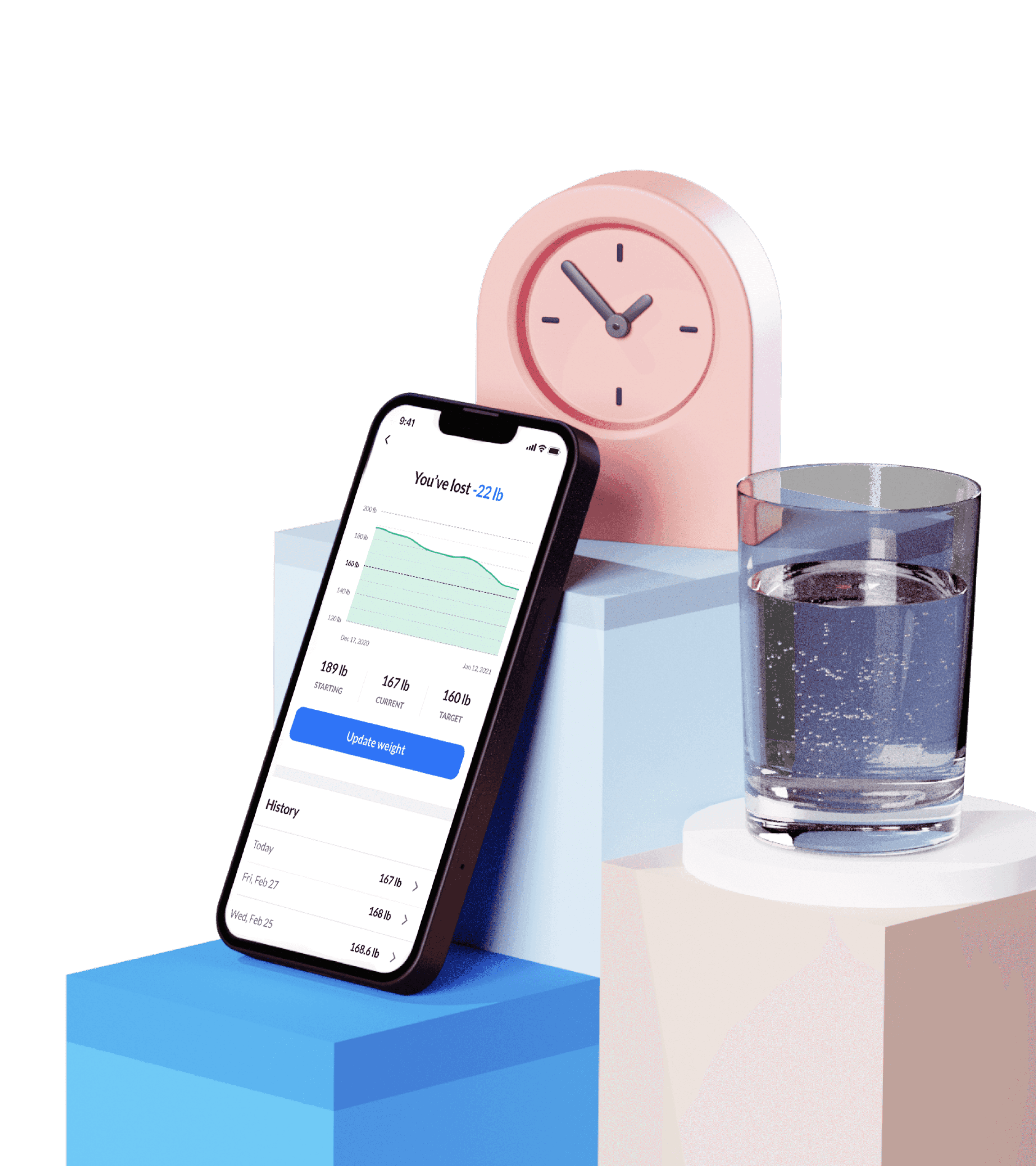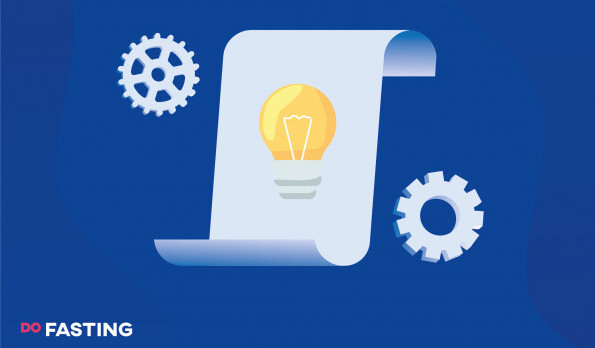Contents
Intermittent Fasting and Weight Loss – How Does It Work?
Intermittent fasting is a dieting tool used to maximize fat loss. After prolonged periods without food, the body exhausts its glucose stores. Without its usual energy supply from glucose, a metabolic switch occurs in which the body begins to burn fat for fuel.
Fasting also enhances weight loss efforts by reducing your daily calorie intake. You’re less likely to consume too many calories with limited hours to eat, mitigating overeating and weight gain.
You can start losing weight fairly early with intermittent fasting. It speeds up the fat-burning process, but overall fat loss takes time. With consistency and strict adherence to your chosen diet, you can expect weight loss results within eight weeks.
However, the exact time it takes to see noticeable weight loss varies between individuals. Key factors that impact weight loss pace for different people include:
- Age, sex, and starting body weight
- Physical activity level, exercise routine, and frequency of exercise
- Eating habits, malnutrition, and choices made in the eating window
- Sleep quality
- The extent of a calorie deficit
The recommendation for healthy weight loss is 1-2 pounds per week. Losing weight rapidly can harm your health as it creates too many physical demands on your body. Side effects include muscle loss, slower metabolism, and nutrient deficiencies.
Take a
1-minute quiz
and discover how much weight you can lose with DoFasting!

What Is an Intermittent Fasting Plateau – And Why Does It Happen?
A weight loss plateau is when your weight is no longer changing after a period of progress. It inevitably happens to every individual that tries to drop a few pounds, despite consistently following a weight loss plan.
An intermittent fasting plateau doesn’t mean intermittent fasting is no longer working for you. Instead, it tends to indicate that your body is re-adapting to your diet.
A plateau usually occurs when you have lost a substantial amount of weight – around 5-10% of your total body weight.
Possible reasons for the plateau include:
- A slower metabolism
- Eating the wrong foods in your eating window
- Eating too close to bedtime
- Cutting your fasting periods short
10 Ways to Break the Intermittent Fasting Plateau
It’s not always easy to identify what is causing your intermittent fasting plateau. Many factors can stall weight loss and leave you frustrated. However, this is not the end of the road. There are many things you can try to overcome this common obstacle.
So, let’s look at 10 tips worth trying to break the plateau.
1. Extend your fasting window
Most beginners start an intermittent fasting journey with a more accessible fast, like the 12-hour fast. While this might have worked well initially, it might be time to extend your fasting window to boost progress.
You can try different types of fasting, with methods like the 16:8 and 18:6 fasts. The longer you fast – the shorter your eating window. Reducing the eating window will help you reduce your overall food intake.
Rather than jumping into a more advanced fast, you can extend your fasting window gradually. Adding chunks of time to your fasting window each day will give your body a chance to adapt and slowly build up to a more prolonged fast.
2. Limit your calorie intake
Calorie restriction is a primary way to help break the plateau. Eating fewer calories can help create a calorie deficit, where you burn more calories than you take in. A calorie deficit is a simple equation and a requisite for weight loss.
For most people, a deficit of 500-750 calories per day is sufficient to lose weight. To reduce your daily calorie intake, try the following tips:
- Increase your fiber and protein intake to help curb your appetite and fight cravings
- Eliminate foods with empty calories that rack up your calorie count without benefiting your body
- Practice portion control
- Drinking water before meals can fill you up and help you eat fewer calories
3. Get enough fiber
Not getting enough fiber can stall weight loss. Dietary fiber intake encourages weight loss by naturally promoting satiety. A fiber-rich meal makes you feel full and satisfied for longer. You are more likely to reduce your overall caloric intake for the day.
Examples of nutritious, high-fiber foods include:
- Beans and legumes
- Whole grains, such as bulgur, buckwheat, and brown rice
- Nuts and seeds
- Many vegetables, such as leafy greens, broccoli, cauliflower, and Brussel sprouts
- Berries
If you want something a little extra, the Essential Fiber Complex from DoFasting is an appetite suppressant designed for intermittent fasting. It contains glucomannan and cellulose – fibers that help keep hunger pangs at bay throughout your fasting window.
4. Cut back on carbs
Along with calorie restriction, cutting back on carbs during your eating hours can speed up weight loss by depleting your glycogen stores. When your body runs out of glucose, it begins tapping into fat stores as an alternative energy supply, reducing fat storage.
Many low-carb diets, like the keto diet, promote significant weight loss. The keto diet is a very low carbohydrate diet that slashes carbs to under 50 grams daily. Participants focus on eating lots of healthy fats and a moderate amount of protein.
If you’re going to cut back on carbs – make sure you limit the right ones. Lots of high-carb foods are highly processed and stripped of nutritional value. Below are examples of high-carb foods to leave out of your intermittent fasting food list.
- Breakfast cereals
- Candy
- Pastries, biscuits, and other baked goods
- French fries and potato chips
- Sugary soda
- White bread, white rice, and white pasta
Take a
1-minute quiz
and discover how much weight you can lose with DoFasting!

5. Eat vegetables at every meal
Vegetables are a staple of a healthy diet plan to promote weight loss. You must eat enough vegetables in your eating windows for optimal health benefits. They are packed with vitamins, minerals, and plenty of fiber to keep you healthy and full at meal times.
For help with meal planning, you can try the DoFasting app. The intermittent fasting assistant contains dozens of recipes to get you to eat more veggies. Each recipe is tailored to fasting to ensure you get the most out of your chosen diet.
6. Get enough good quality sleep
Getting enough sleep is a major factor in living a healthy lifestyle.
A good night’s sleep during intermittent fasting can help with weight loss. Insufficient sleep and sleep deprivation alter hormones, increasing appetite and the likelihood of eating unhealthy foods. It can also influence how your body stores fat. These elements can throw your diet off course and make it difficult to sustain longer fasts.
Healthy adults should aim to sleep 7 or more hours per night to promote optimal sleep. If you struggle to complete a full night’s sleep, you can improve sleep quality in several ways:
- Stick to a sleep schedule that sets aside at least 7 hours of sleep per night.
- Go to bed at the same time every night and get up at the same time each morning.
- Follow a healthy wake-up routine that gets you ready for the day.
- Limit sleep disturbances by putting your phone away and creating a restful environment.
- Cut the daytime naps.
7. Manage stress
Stress can negatively affect your weight loss progress and impact weight maintenance.
Rises in cortisol hormone levels can increase appetite and cravings and lead people to gain weight. It’s also possible that stress-induced behavior, like comfort eating and incorrect eating patterns, is the cause of your weight loss plateau.
Stress management can help you get things back on track. There are many ways to manage and reduce stress. Popular practices include exercise, meditation, deep breathing, connecting with others, and eating a healthful diet.
8. Start exercising
Exercise training is critical to boost intermittent fasting weight loss and achieve your body composition goals. It helps you burn more calories to create an energy deficit and is essential for losing fat and maintaining muscle mass.
There are lots of activities you can try. If working out in the fasting period, it’s best to stick with mild to moderate intensity workouts and save the intensive workouts for the eating period when you have more energy.
Walking, yoga, and pilates are good choices for a fast workout. Resistance or strength training will help you hang on to lean mass while burning stubborn body fat.
9. Take exogenous ketones
Exogenous ketones are ketone bodies that you ingest from external sources like foods and supplements. Taking these ketones alongside intermittent fasting or the keto diet can speed up the metabolic switch to ketosis and accelerate fat burning.
Many ketone supplements also suppress appetite and boost your energy levels. This can help you power through your fasts and push past the intermittent fasting plateau. You can take supplements on an empty stomach to fuel your day.
10. Reduce alcohol
Alcoholic drinks are high in calories. You should reduce your alcohol intake when trying to lose weight. Daily and occasional alcohol consumption are associated with elevated BMI, weight gain, and increased risk of chronic conditions.
If you drink alcohol during the fasting period, you will immediately break your fast. While you can consume alcohol during the eating period, you will likely take in too many calories. It will prevent you from creating an energy deficit and stall weight loss.
Don’t Rely on the Scale Alone
Fat loss might be your focus, but it’s important not to ask too much of yourself. Weight loss progress varies from person to person, and you will lose weight in your own time. Obsessively monitoring your body weight can become unhealthy.
A weight scale is handy for recording weight loss, but it is often better suited to weight maintenance. For many people, stepping foot on this device has adverse effects, especially if the number on the scale won’t budge.
If you’re keen to track your progress, there are some alternative methods you can try. These methods offer more empowering ways to witness weight loss and can help you feel good about your progress rather than setting you back in the blink of an eye.
For example, you could:
- Take your body measurements using a tape measure
- Try on old clothes and see how they fit
- Slip into a pair of old jeans and see how tight or loose-fitting they are
- Take photos to track your progress visually
- Track your workouts in a journal to see your improvements
Take a
1-minute quiz
and discover how much weight you can lose with DoFasting!

Conclusion
There you have it. We’ve covered the most likely causes of a fasting weight loss plateau and how to shift your body back into fat-burning mode. With our top intermittent fasting tips, you can begin losing weight again and conquer your goals.
See how DoFasting will improve your life
Find out what works for you with this 60-sec quiz approved by our experts and get your personal revolutionary fasting assistant.
Start the Quiz














